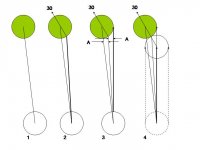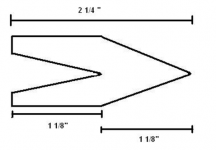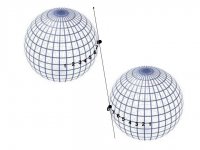DD Aiming:
I start to aim while standing to find the contact point on the OB that when impacted by the CB will send the OB to the pocket or a point on the rail when banking.
I use a center cue ball hit on most shots for the CB will roll straight and not influenced by english that can cause the CB to curve as it travels down table and alters the desired contact point on the OB.
I use double distance (DD) aiming (double the distance from the center of the OB to the CP to the outside) with a center CB hit – no english. If outside english will get me shape on the next ball, I will apply BHE when down. The amount of BHE varies with the shot and must include adjustments for the curve and throw.
If inside english will get me shape on the next ball, I parallel shift the cue with both the bridge and grip hands to the inside (toward the OB) of the CB center when down. The amount of the shift varies with the shot and must include adjustments for the curve and throw.
Double distance aiming breaks down when the CB and OB are too close together and must be a bit more than DD.
Be well.
I start to aim while standing to find the contact point on the OB that when impacted by the CB will send the OB to the pocket or a point on the rail when banking.
I use a center cue ball hit on most shots for the CB will roll straight and not influenced by english that can cause the CB to curve as it travels down table and alters the desired contact point on the OB.
I use double distance (DD) aiming (double the distance from the center of the OB to the CP to the outside) with a center CB hit – no english. If outside english will get me shape on the next ball, I will apply BHE when down. The amount of BHE varies with the shot and must include adjustments for the curve and throw.
If inside english will get me shape on the next ball, I parallel shift the cue with both the bridge and grip hands to the inside (toward the OB) of the CB center when down. The amount of the shift varies with the shot and must include adjustments for the curve and throw.
Double distance aiming breaks down when the CB and OB are too close together and must be a bit more than DD.
Be well.







